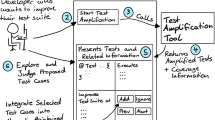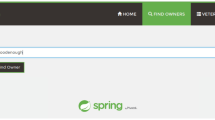Abstract
Software architectures such as plug-in and service-oriented architectures enable developers to build extensible software products, whose functionality can be enriched by adding or configuring components. A well-known example of such an architecture is Eclipse, best known for its use to create a series of extensible IDEs. Although such architectures give users and developers a great deal of flexibility to create new products, the complexity of the built systems increases. In order to manage this complexity developers use extensive automated test suites. Unfortunately, current testing tools offer little insight in which of the many possible combinations of components and components configurations are actually tested. The goal of this paper is to remedy this problem. To that end, we interview 25 professional developers on the problems they experience in test suite understanding for plug-in architectures. The findings have been incorporated in five architectural views that provide an extensibility perspective on plug-in-based systems and their test suites. The views combine static and dynamic information on plug-in dependencies, extension initialization, extension and service usage, and the test suites. The views have been implemented in ETSE, the Eclipse Plug-in Test Suite Exploration tool. We evaluate the proposed views by analyzing eGit, Mylyn, and a Mylyn connector.



















Similar content being viewed by others
Notes
This style is originally from domain-driven design (Evans 2003).
Drawn using UMLet version 11.3 (see http://www.umlet.com/).
ETSE is available at http://swerl.tudelft.nl/bin/view/Main/ETSE.
ETSE can also export graphs as dot-files, which can then be visualized with GraphViz.
This class is in the package org.eclipse.ui.views.markers.
This class is in the package org.eclipse.core.commands.
References
Adolph S, Hall W, Kruchten P (2011) Using grounded theory to study the experience of software development. Empir Software Eng 16(4):487–513
Binder RV (1999) Testing object-oriented systems: models, patterns, and tools. Addison-Wesley Professional
Bryant A, Charmaz K (2007) The SAGE handbook of grounded theory. SAGE
Chatley R, Eisenbach S, Kramer J, Magee J, Uchitel S (2004) Predictable dynamic plugin systems. In: 7th international conference on fundamental approaches to software engineering (FASE). Springer, pp 129–143
Corbin JM, Strauss A (1990) Grounded theory research: Procedures, canons, and evaluative criteria. Qual Sociol 13:3–21
Cornelissen B, van Deursen A, Moonen L, Zaidman A (2007) Visualizing testsuites to aid in software understanding. In: Proceedings of the 11th European conference on software maintenance and reengineering (CSMR’07). IEEE Computer Society, pp 213–222
Cornelissen B, Zaidman A, van Deursen A, Moonen L, Koschke R (2009) A systematic survey of program comprehension through dynamic analysis. IEEE Trans Softw Eng 35(5):684–702
Dagenais B, Robillard MP (2010) Creating and evolving developer documentation: understanding the decisions of open source contributors. In: Proceedings foundations of sofatware engineering (FSE). ACM SIGSOFT, pp 127–136
Demeyer S, Ducasse S, Nierstrasz O (2003) Object-oriented reengineering patterns. Morgan Kaufmann
Evans E (2003) Domain-driven design: tackling complexity in the heart of software, 1. a. edn. Addison-Wesley Professional
Feathers M (2004) Working effectively with legacy code. Prentice Hall
Freeman S, Pryce N (2010) Growing object-oriented software, guided by tests. Addison-Wesley
Gaelli M, Lanza M, Nierstrasz O (2005) Towards a taxonomy of SUnit tests. In: 13th international european smalltalk conference (ESUG 2005), pp 1–22
Gamma E, Beck K (2003) Contributing to eclipse: principles, patterns, and plugins. Addison Wesley Longman Publishing Co., Inc., Redwood City, CA, USA
Garousi V, Koochakzadeh N (2010) An empirical evaluation to study benefits of visual versus textual test coverage information. In: Proceedings of the 5th international academic and industrial conference on testing—practice and research techniques, TAIC PART’10. Springer, Berlin, pp 189–193
Glaser B, Strauss A (1967) The discovery of grounded theory: strategies for qualitative research. Aldine Transaction
Greiler M, van Deursen A, Storey MA (2012) Test confessions: a study of testing practices for plug-in systems. In: Proceedings of the 2012 international conference on software engineering, ICSE 2012. IEEE Press, Piscataway, pp 244–254
Greiler M, Groß HG, van Deursen A (2010) Understanding plug-in test suites from an extensibility perspective. In: Proceedings 17th working conference on reverse engineering (WCRE). IEEE Computer Society, pp 67–76
Hartmann J, Imoberdorf C, Meisinger M (2000) UML-based integration testing. In: International symposium on software testing and analysis. ACM, pp 60–70
Hermans F, Pinzger M, van Deursen A (2011) Supporting professional spreadsheet users by generating leveled dataflow diagrams. In: Gall H, Medvidovic N (eds) Proceedings 33rd international conference on software engineering (ICSE 2011). ACM
Jorgensen PC, Erickson C (1994) Object-oriented integration testing. Commun ACM 37(9):30
Koochakzadeh N, Garousi V (2010) Tecrevis: a tool for test coverage and test redundancy visualization. In: Proceedings of the 5th international academic and industrial conference on testing—practice and research techniques, TAIC PART’10. Springer, Berlin, pp 129–136
Marquardt K (1999) Patterns for plug-ins. In: Proceedings 4th european conference on pattern languages of programs (EuroPLoP). Bad Irsee, Germany, p 37
Martin RC (2008) Clean code: a handbook of agile software craftsmanship, 1 edn. Prentice Hall PTR, Upper Saddle River
Mayer J, Melzer I, Schweiggert F (2003) Lightweight plug-in-based application development. In: International conference NetObjectDays, NODe 2002. Springer, pp 87–102
Mens T, Fernández-Ramil J, Degrandsart S (2008) The evolution of eclipse. In: Proceedings 24th IEEE international conference on software maintenance (ICSM). IEEE, pp 386–395
Meszaros G (2007) xUnit test patterns: refactoring test code. Addison-Wesley
Pezzè M, Young M (2008) Software testing and analysis. Wiley
Reis S, Metzger A, Pohl K (2007) Integration testing in software product line engineering: a model-based technique. In: Lecture notes in computer science, pp 321–335
Rigby PC, Storey MA (2011) Understanding broadcast based peer review on open source software projects. In: ICSE ’11: Proceedings of the 33rd international conference on software engineering. ACM
Rountev A, Milanova A, Ryder B (2004) Fragment class analysis for testing of polymorphism in Java software. IEEE Trans Softw Eng 30(6):372–387
Rubio D (2009) Testing with spring and OSGi, chap 9. Apress, Berkeley, CA, pp 331–359
Shavor S, D’Anjou J, Fairbrother S, Kehn D, Kellerman J, McCarthy P (2005) The Java developer’s guide to Eclipse. Addison-Wesley Longman, Boston
The OSGi Alliance (2011) OSGi Service Platform Core Specification; Release 4, Version 4.3. http://www.osgi.org. Accessed 22 Aug 2011
van Deursen A, Hofmeister C, Koschke R, Moonen L, Riva C. (2004) Symphony: view-driven software architecture reconstruction. In: Proceedings working IEEE/IFIP conference on software architecture (WICSA’04). IEEE Computer Society Press, pp 122–134
van Deursen A, Moonen L, van Den Bergh A, Kok G (2002) Refactoring test code. In: Succi G, Marchesi M, Wells D, Williams L (eds) Extreme programming perspectives. Addison Wesley, pp 141–152
van Rompaey B, Du Bois B, Demeyer S, Rieger M (2007) On the detection of test smells: a metrics-based approach for general fixture and eager test. IEEE Trans Softw Eng 33(12):800–817
Wermelinger M, Yu Y (2008) Analyzing the evolution of eclipse plugins. In: Proceedings of the 2008 international working conference on mining software repositories, MSR ’08. ACM, New York, pp 133–136
Zaidman A, van Rompaey B, Demeyer S, van Deursen A (2008) Mining software repositories to study co-evolution of production & test code. In: Proceedings 1st international conference on software testing verification and validation (ICST). IEEE Computer Society, pp 220–229
Author information
Authors and Affiliations
Corresponding author
Additional information
Editors: Giulio Antoniol and Martin Pinzger
Rights and permissions
About this article
Cite this article
Greiler, M., van Deursen, A. What your plug-in test suites really test: an integration perspective on test suite understanding. Empir Software Eng 18, 859–900 (2013). https://doi.org/10.1007/s10664-012-9235-7
Published:
Issue Date:
DOI: https://doi.org/10.1007/s10664-012-9235-7




